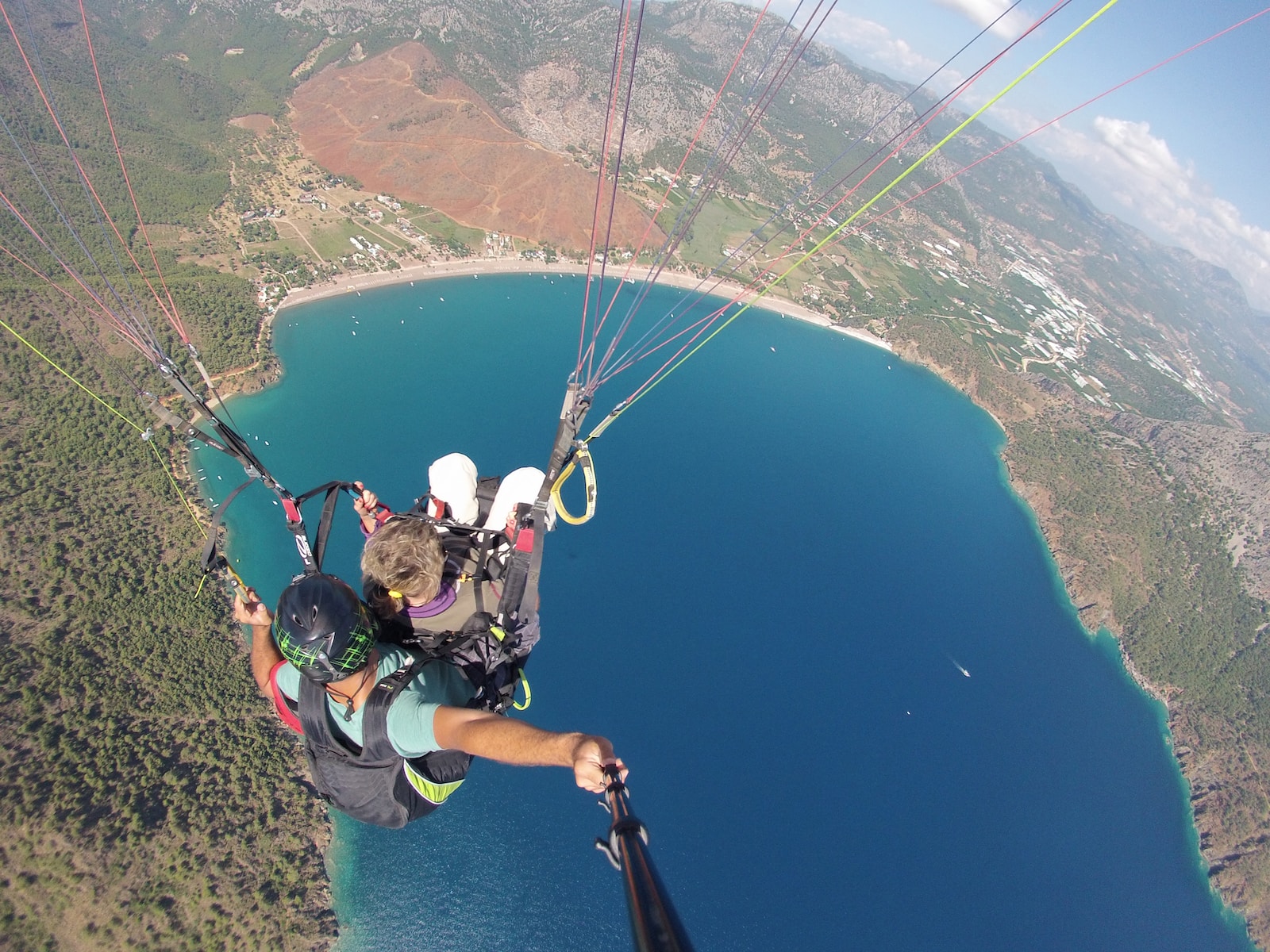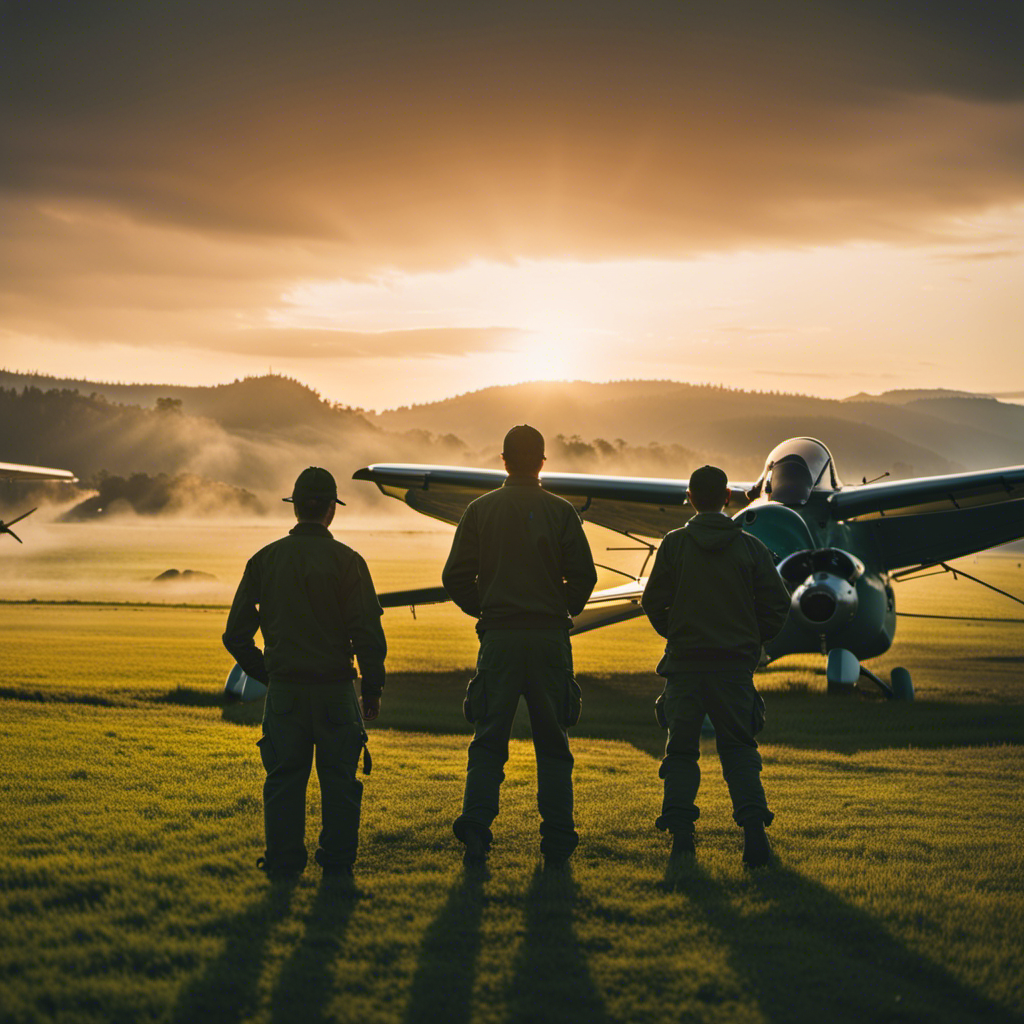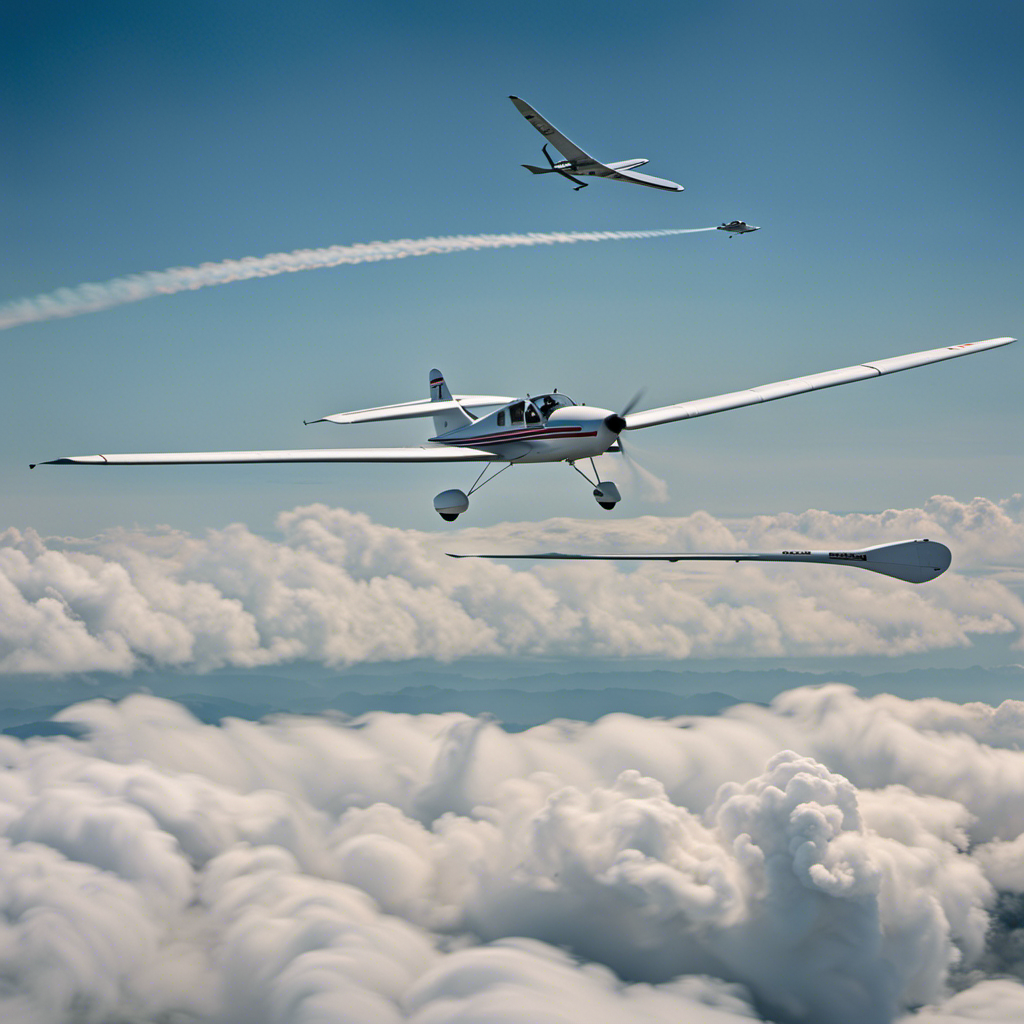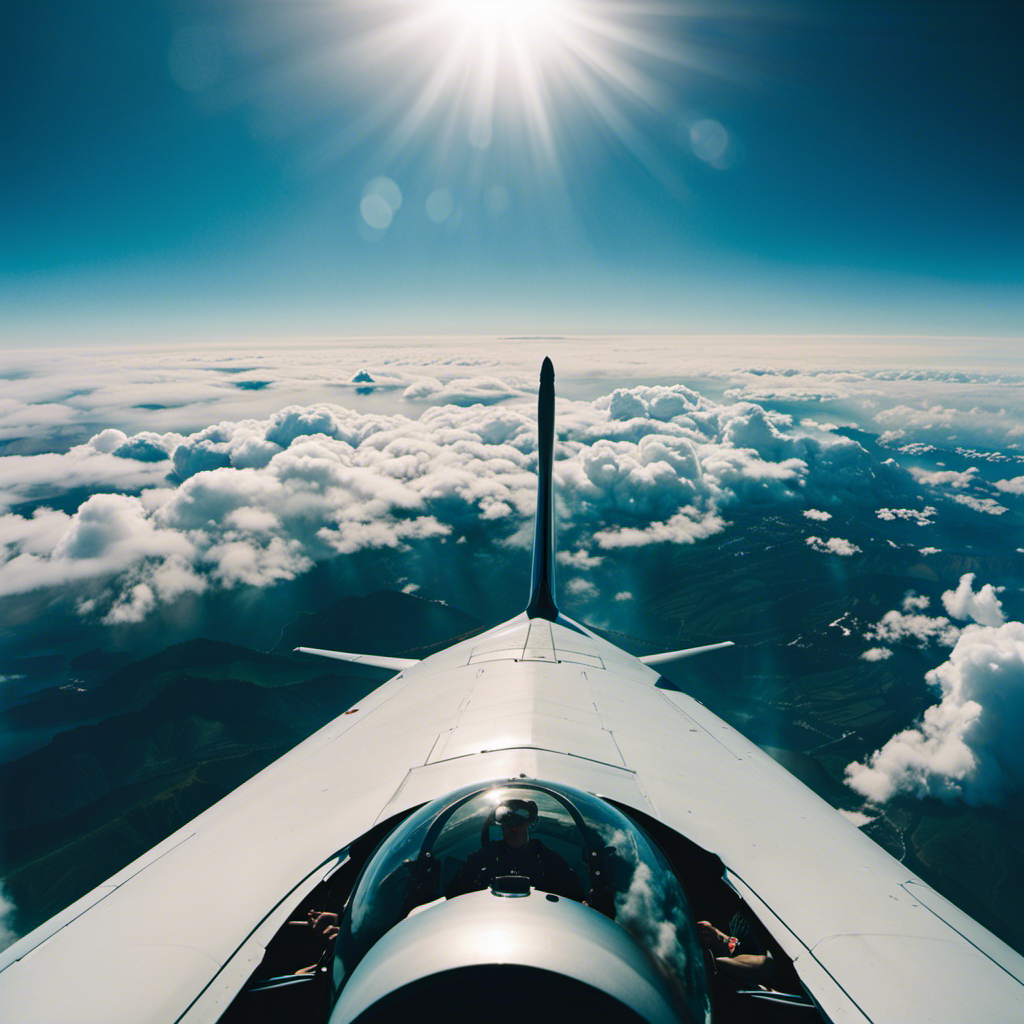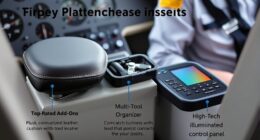As a seasoned pilot, I can guarantee you that flying feels like gliding on the wings of a dream.
If you’ve ever wondered how to start learning to fly a plane, look no further. In this article, I will guide you through the process step by step, sharing my expertise and giving you the tools you need to take to the skies.
From finding a reputable flight school to obtaining a medical certificate, we’ll cover it all.
So, buckle up and let’s embark on this exhilarating journey together.
Key Takeaways
- Consider the cost of training and look for financial assistance options.
- Gain flight hours and experience to become a proficient pilot.
- Prepare for the written exam by creating a study schedule and utilizing resources.
- Demonstrate skills and knowledge in the practical flight test and seek feedback from experienced instructors.
Understand the Requirements and Commitment
You’ll need to understand the requirements and commitment involved in learning to fly a plane. It’s not just about sitting in the cockpit and taking off into the sky.
There are financial considerations to take into account. Learning to fly can be an expensive endeavor, with costs including aircraft rental, fuel, insurance, and instructor fees. It’s important to have a clear understanding of your budget and how much you can afford to invest in your training.
Additionally, setting realistic goals is crucial. Learning to fly takes time and dedication. You’ll need to commit to regular lessons and practice sessions to build your skills and knowledge. This requires a level of discipline and commitment that should not be underestimated.
Once you understand the financial commitment and have set realistic goals, it’s time to find a reputable flight school or instructor.
Find a Reputable Flight School or Instructor
Finding a reputable flight school or instructor can be crucial when beginning your journey to becoming a pilot. The process of learning to fly a plane requires technical knowledge and precise training.
When selecting a flight school or instructor, it is important to consider several factors, including choosing the right aircraft and financial considerations. The choice of aircraft will depend on your goals and preferences, as different planes have varying capabilities and requirements. Financial considerations, such as the cost of training and the availability of financing options, should also be taken into account.
Once you have found a reputable flight school or instructor, the next step is to obtain a medical certificate, which is a requirement for all pilots. This certificate ensures that you are physically fit to fly and is an essential part of the process.
Obtain a Medical Certificate
After completing your training, it’s important to schedule an appointment with an aviation medical examiner to obtain your medical certificate. This certificate is a requirement for pursuing aviation careers and ensures that you are physically fit to fly a plane.
Here are a few key points to consider:
- The medical examination will assess your overall health and any medical conditions that may affect your ability to safely operate an aircraft.
- The examiner will evaluate your vision, hearing, cardiovascular health, and mental well-being.
- It’s crucial to bring any necessary documentation, such as a list of medications or medical history, to the appointment.
Obtaining your medical certificate is an essential step in your journey towards becoming a pilot. It lays the foundation for a successful aviation career. Once you have your certificate, you can then proceed to the next phase: ground school training.
Start with Ground School Training
When it comes to learning to fly a plane, it is essential to start with a solid foundation in the basics of aviation. This includes understanding the principles of flight, aerodynamics, and aircraft control.
Additionally, studying airplane systems and instruments is crucial to ensure safety and efficient operation.
Lastly, a thorough understanding of navigation and weather is essential for planning and executing flights, as well as for making informed decisions while in the air.
Learn the Basics of Aviation
To get started in aviation, it’s important to learn the basics of flying a plane. Here are four essential steps to help you on your journey:
-
Utilize learning resources: There are various resources available to help you understand the fundamentals of aviation. Books, online courses, and instructional videos are great tools to enhance your knowledge.
-
Embrace flight simulation: Flight simulators provide a realistic virtual environment where you can practice flying without leaving the ground. These simulations allow you to familiarize yourself with the controls, procedures, and different flight scenarios.
-
Seek guidance from experienced pilots: Connecting with experienced pilots can provide valuable insights and tips. Joining aviation forums or local flying clubs can help you find mentors who can share their expertise and guide you through your learning process.
-
Take introductory flight lessons: Hands-on experience is crucial in aviation. Enrolling in an introductory flight lesson will give you the opportunity to sit in the pilot’s seat, handle the controls, and experience the thrill of flying firsthand.
Understanding the basics of aviation sets the foundation for your journey towards becoming a pilot. As you progress, it’s essential to dive deeper into studying airplane systems and instruments, which we will explore in the next section.
Study Airplane Systems and Instruments
After gaining a solid understanding of the basics of aviation, it is time to delve deeper into the world of flying. This next step is crucial in your journey towards becoming a pilot: studying airplane systems and instruments.
Understanding aircraft maintenance is a fundamental aspect of aviation. It entails comprehending the intricate workings of the plane, including its engine, electrical systems, and fuel systems. Additionally, it involves learning how to perform routine inspections and identify any potential issues that may arise during flight.
Mastering flight controls is equally essential. This involves becoming familiar with the primary controls, such as the yoke or control column, rudder pedals, and throttle. It also entails understanding how these controls affect the aircraft’s attitude, altitude, and speed.
By developing a deep comprehension of airplane systems and instruments, you will be well-prepared to navigate the skies with confidence.
Transitioning into the subsequent section, understanding navigation and weather is crucial for safe and efficient flight.
Understand Navigation and Weather
Understanding navigation and weather is vital for pilots to safely and efficiently navigate the skies. As a pilot, I know the importance of thorough pre-flight checks and procedures. Before every flight, I meticulously inspect the aircraft, ensuring that all systems are functioning properly and that there are no safety concerns.
Additionally, I carefully review weather reports and forecasts to assess any potential hazards that may affect the flight. Technology plays a significant role in aviation navigation, providing pilots with accurate and real-time information about their position, heading, and weather conditions. From GPS systems to weather radar, these advanced tools enhance situational awareness and assist in making informed decisions.
By understanding navigation and weather, pilots can confidently plan their routes and make adjustments as necessary, ensuring a safe and successful journey through the skies.
Now, let’s transition into the next section and begin flight training.
Begin Flight Training
Before starting flight training, it’s important to research and choose a reputable flight school. Here are some key considerations when embarking on this exciting journey:
-
Cost of Training
-
Look into the tuition fees, aircraft rental rates, and any additional expenses such as textbooks and examination fees.
-
Consider scholarships, grants, or financing options that may be available to help offset the expenses.
-
Time Commitment
-
Understand the expected duration of the training program, including both ground school and flight lessons.
-
Take into account your personal schedule and commitments to ensure you can dedicate sufficient time to your training.
When beginning flight training, it’s crucial to select a flight school that aligns with your budget and time availability. Once you’ve made this important decision, you can move forward and start building your flight hours and experience, which will be the focus of the subsequent section.
Build Flight Hours and Experience
Once you’ve completed your flight training, you can begin accumulating flight hours and gaining valuable experience. Building experience and gaining flight time are crucial steps in your journey to becoming a proficient pilot.
As you log more hours in the air, you will become more comfortable and confident in handling different aircraft and weather conditions. It is during this phase that you will truly start to refine your skills and develop a deeper understanding of aviation principles.
Each flight will present unique challenges and opportunities for growth. By actively seeking out diverse flying experiences, such as cross-country flights or flying in different airspace, you can broaden your knowledge and enhance your abilities as a pilot.
As you continue to build your flight hours and experience, you will be better prepared to take the next step and prepare for and pass the written exam, which is an essential milestone in your aviation journey.
Prepare for and Pass the Written Exam
Studying for and passing the written exam is a crucial step in becoming a proficient pilot. As an experienced pilot, I have developed effective study techniques and test preparation strategies that have helped me succeed in this challenging aspect of flight training.
To ensure thorough understanding of the material, I create a study schedule and break down the topics into manageable chunks. I utilize a combination of resources, such as textbooks, online courses, and practice exams, to broaden my knowledge base and reinforce key concepts. Additionally, I find it helpful to work through sample questions and review the explanations to gain a deeper understanding of the subject matter.
By employing these study techniques and thorough test preparation, I am able to confidently approach the written exam and achieve a successful outcome.
Looking ahead, it is now time to transition into the subsequent section about taking the practical flight test.
Take the Practical Flight Test
During the practical flight test, you’ll be evaluated on your ability to demonstrate the skills and knowledge necessary to safely operate an aircraft. As someone who has been through this test, I understand the anxiety it can bring.
Here are some tips for managing test anxiety during the practical flight test. First, remember to breathe and stay focused on the task at hand. Visualization techniques can also be helpful in calming nerves.
Additionally, make sure to review and practice all the maneuvers thoroughly beforehand. Common challenges faced during the practical flight test include maintaining altitude and airspeed, performing precise landings, and managing distractions. To overcome these challenges, practice regularly and seek feedback from experienced instructors.
Continue Training and Pursue Advanced Certifications
To further enhance your skills and knowledge as a pilot, you should consider continuing your training and pursuing advanced certifications. This will not only make you a more competent and confident pilot, but it will also open up new opportunities and expand your career prospects.
Here are three reasons why advanced pilot licenses and specialized flight training are beneficial:
-
Increased expertise: By obtaining advanced certifications, such as an instrument rating or a commercial pilot license, you will acquire a deeper understanding of complex flight operations and navigation techniques. This will enable you to handle challenging weather conditions and fly more sophisticated aircraft.
-
Expanded career options: Having advanced pilot licenses and specialized training will make you a desirable candidate for a variety of aviation roles. Whether you aspire to become a flight instructor, charter pilot, or even fly for major airlines, these certifications will provide you with the necessary qualifications to pursue your dream job.
-
Enhanced safety: Advanced training not only improves your skills, but it also enhances your ability to handle emergency situations. Through specialized flight training, you will learn advanced maneuvering techniques, emergency procedures, and risk management strategies, ensuring that you can navigate any unexpected challenges that may arise during flight.
Join Aviation Communities and Network with Fellow Pilots
Joining aviation communities and networking with fellow pilots can provide valuable insights and connections to enhance your aviation experience. As a pilot myself, I have found that being part of pilot clubs and attending aviation events has been instrumental in my growth and development in the field.
These communities offer a platform to connect with like-minded individuals who share the same passion for flying. Through discussions, forums, and social gatherings, I have gained valuable knowledge and tips from experienced pilots.
Additionally, attending aviation events provides opportunities to learn about the latest advancements in aviation technology and industry trends. It is also a great way to meet industry professionals, potential mentors, and even potential job opportunities.
Frequently Asked Questions
What is the average cost of flight training?
The average cost of flight training can vary depending on factors such as the type of aircraft, location, and instructor fees. Flight training expenses can range from $5,000 to $15,000 or more.
How long does it take to obtain a private pilot’s license?
Obtaining a private pilot’s license is a breeze. With an average duration of just a few months and minimal training requirements, you’ll be soaring through the skies in no time. It’s a piece of cake!
Can I become a pilot if I wear glasses or contact lenses?
Yes, you can become a pilot with visual impairment, as long as you have corrective eyewear. I personally wear glasses/contact lenses and have obtained my pilot’s license successfully.
Are there any height or weight restrictions for becoming a pilot?
Height and weight restrictions for pilots are determined by the aircraft’s design and safety regulations. However, physical disabilities can prevent someone from becoming a pilot if they hinder their ability to perform necessary tasks. Remember, "where there’s a will, there’s a way."
Can I start flight training without any prior experience in aviation?
Yes, flight training can be pursued without prior aviation experience. However, be prepared for a steep learning curve and the necessary qualifications, such as obtaining a student pilot license and completing ground and flight training.
Conclusion
In conclusion, embarking on the journey to learn how to fly a plane requires dedication, commitment, and a passion for aviation. It is an exhilarating experience that opens up a whole new world of possibilities.
As an experienced pilot, I can attest to the fact that the aviation community is a tight-knit group, and joining it offers endless opportunities for networking and learning from fellow pilots. Did you know that only 0.2% of the world’s population holds a pilot’s license? This staggering statistic highlights the rarity and privilege of being a pilot, making it even more special.
So, if you have the aspiration to soar through the skies, don’t hesitate to take the leap and start your journey towards becoming a pilot.
With a heart that soars as high as the skies, Aria, affectionately known as “Skylark,” is the driving force behind Soaring Skyways. Her journey into the gliding world began as a young dreamer gazing up at the soaring birds, yearning to experience the weightlessness and freedom they embodied. With years of experience both in the cockpit and behind the scenes, Aria’s commitment to the gliding community is unwavering.

